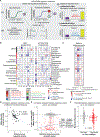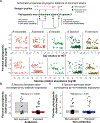High-resolution analyses of associations between medications, microbiome, and mortality in cancer patients
- PMID: 37295406
- PMCID: PMC10390075
- DOI: 10.1016/j.cell.2023.05.007
High-resolution analyses of associations between medications, microbiome, and mortality in cancer patients
Abstract
Discerning the effect of pharmacological exposures on intestinal bacterial communities in cancer patients is challenging. Here, we deconvoluted the relationship between drug exposures and changes in microbial composition by developing and applying a new computational method, PARADIGM (parameters associated with dynamics of gut microbiota), to a large set of longitudinal fecal microbiome profiles with detailed medication-administration records from patients undergoing allogeneic hematopoietic cell transplantation. We observed that several non-antibiotic drugs, including laxatives, antiemetics, and opioids, are associated with increased Enterococcus relative abundance and decreased alpha diversity. Shotgun metagenomic sequencing further demonstrated subspecies competition, leading to increased dominant-strain genetic convergence during allo-HCT that is significantly associated with antibiotic exposures. We integrated drug-microbiome associations to predict clinical outcomes in two validation cohorts on the basis of drug exposures alone, suggesting that this approach can generate biologically and clinically relevant insights into how pharmacological exposures can perturb or preserve microbiota composition. The application of a computational method called PARADIGM to a large dataset of cancer patients' longitudinal fecal specimens and detailed daily medication records reveals associations between drug exposures and the intestinal microbiota that recapitulate in vitro findings and are also predictive of clinical outcomes.
Keywords: 16S sequencing; computational modeling; hematopoietic cell transplantation; metagenomics; microbiota; pharmacological exposures.
Copyright © 2023 Elsevier Inc. All rights reserved.
Conflict of interest statement
Declaration of interests MSKCC has financial interests relative to Seres Therapeutics. M.R.M.v.d.B. has received research support from Seres Therapeutics; has consulted, received honorarium from, or participated in advisory boards for Seres Therapeutics, WindMIL therapeutics, Rheos, Frazier Healthcare Partners, Nektar Therapeutics, Notch Therapeutics, Forty Seven, Priothera, Ceramedix, Lygenesis, Pluto Immunotherapeutics, Magenta Therapeutics, Merck & Co, and DKMS Medical Council (Board); has IP licensing with Seres Therapeutics and Juno Therapeutics; and has stock options from Seres and Notch Therapeutics. J.U.P. reports research funding, intellectual property fees, and travel reimbursement from Seres Therapeutics and consulting fees from DaVolterra, CSL Behring, and MaaT Pharma; serves on an advisory board of and holds equity in Postbiotics Plus Research; and has filed intellectual property applications related to microbiome. K.A.M. is on the advisory board for and holds stock in PostBiotics Plus and has served in an advisory role and received honoraria from Incyte. R.S. has served on an advisory board for Medexus. B.G. received research funding from Actinium Pharmaceuticals. E.G.P. serves on the advisory board of Diversigen and has received speaker honoraria from Bristol-Myers Squibb, Celgene, Seres Therapeutics, MedImmune, Novartis, and Ferring Pharmaceuticals; is an inventor on patents related to microbiome; and holds patents that receive royalties from Seres Therapeutics. A.D.S. has received research funding from Merck, Novartis, and Seres; has received honoraria from Abbott Nutrition; has consulted for AVROBIO and Targazyme; and has received research supplies from Clasado and DSM/iHealth. M.A.P. reports honoraria from Adicet, Allovir, Caribou Biosciences, Celgene, Bristol-Myers Squibb, Equilium, Exevir, Incyte, Karyopharm, Kite/Gilead, Merck, Miltenyi Biotec, MorphoSys, Nektar Therapeutics, Novartis, Omeros, OrcaBio, Syncopation, VectivBio AG, and Vor Biopharma; serves on DSMBs for Cidara Therapeutics, MediGene, and Sellas Life Sciences and the scientific advisory board of NexImmune; has ownership interests in NexImmune, Omeros, and OrcaBio; and has received institutional research support for clinical trials from Incyte, Kite/Gilead, Miltenyi Biotec, Nektar Therapeutics, and Novartis. N.J.C. is on DSMBs for Fate Therapeutics, Takeda, and Celularity. A.L.C.G. is currently employed by and has stock options at Xbiome Inc.
Figures





Comment in
-
Medication effects on the gut microbiome in allo-HCT.Cell. 2023 Jun 8;186(12):2520-2523. doi: 10.1016/j.cell.2023.04.011. Epub 2023 Jun 8. Cell. 2023. PMID: 37295398
-
PARADIGM Identifies Associations between Drugs, the Microbiome, and Mortality.Cancer Discov. 2023 Aug 4;13(8):1757. doi: 10.1158/2159-8290.CD-RW2023-096. Cancer Discov. 2023. PMID: 37350637
References
-
- Johnson AJ, Vangay P, Al-Ghalith GA, Hillmann BM, Ward TL, Shields-Cutler RR, Kim AD, Shmagel AK, Syed AN, Personalized Microbiome Class S, et al. (2019). Daily Sampling Reveals Personalized Diet-Microbiome Associations in Humans. Cell Host Microbe 25, 789–802 e785. 10.1016/j.chom.2019.05.005. - DOI - PubMed
Publication types
MeSH terms
Substances
Grants and funding
- P01 CA023766/CA/NCI NIH HHS/United States
- R01 CA228308/CA/NCI NIH HHS/United States
- U01 AI124275/AI/NIAID NIH HHS/United States
- R56 AI137269/AI/NIAID NIH HHS/United States
- R01 HL125571/HL/NHLBI NIH HHS/United States
- R01 CA228358/CA/NCI NIH HHS/United States
- R01 HL123340/HL/NHLBI NIH HHS/United States
- R21 AG066388/AG/NIA NIH HHS/United States
- R01 HL151365/HL/NHLBI NIH HHS/United States
- P30 CA008748/CA/NCI NIH HHS/United States
- P01 AG052359/AG/NIA NIH HHS/United States
- K08 HL143189/HL/NHLBI NIH HHS/United States
- R01 CA203950/CA/NCI NIH HHS/United States
LinkOut - more resources
Full Text Sources
Medical

